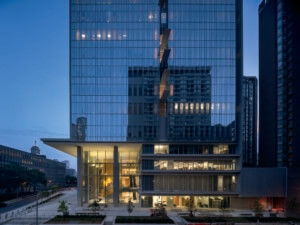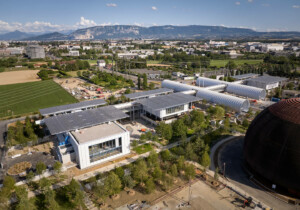Last year, the Stavros Niarchos Foundation Cultural Center, a 1.28 million-square-foot complex built into an artificial hill in Athens, was inaugurated to great fanfare. The building will provide two institutions, the National Library of Greece and the Greek National Opera, pristine new homes, and it is a significant addition to the Athens cultural landscape.
This year saw a related achievement: the publication of Victoria Newhouse’s Chaos and Culture: Renzo Piano Building Workshop and the Stavros Niarchos Foundation Cultural Center in Athens, a richly detailed account of the creation of the $800 million complex. The book could have been a dud; after all, as Newhouse herself notes, the realization of the Athens project was “nearly trouble-free.”
But Newhouse lucked out, in part because Greece didn’t: The country was in dire financial and political straits for most of the time the complex was in the works, providing the “chaos” of the title. Only the commitment of the deep-pocketed Stavros Niarchos Foundation kept the project on track. But the plan was always that the complex, once completed, would be turned over to the Greek government, which would operate it with taxpayer funds—a result that now seems unrealistic. (Worse, the agreement between the foundation and the government stipulates that if the government fails to meet its obligation to operate the Center, it will refund the foundation’s entire investment in the project—money the government doesn’t appear to have.) So the book became as much a tale of politics and economics as of architecture. And right now, that tale is a cliffhanger: neither the library nor the opera house has fully moved into the building.
True, there is some architectural intrigue, usually involving firms other than the always-dependable Renzo Piano Building Workshop (RPBW): Newhouse details the master-planning work of the New York firm Cooper Robertson that preceded the selection of RPBW to design the complex. She then reports that almost nothing of the master plan can be seen in the RPBW design. And she delves into the hiring, in 2013, of the Dutch firm Mecanoo, to rethink RPBW’s library design. Newhouse writes:
The idea that work by Renzo Piano—winner of a Pritzker Prize, among numerous other awards—could be corrected by anyone, let alone a far less known firm, would be surprising under any circumstances. What made it especially so is the stark disparity of styles between the two offices.
But Piano prevailed: “Having initially greeted [Mecanoo founder Francine] Houben with his usual charm, the Italian architect barely glanced at the Mecanoo proposal in late 2013 before rejecting it out of hand.”
In the course of writing the book, Newhouse developed expertise on subjects as diverse as the history of philanthropy in the Ottoman world and the acoustical preferences of Southern Europeans. The book is a kind of encyclopedia.
But there is one significant lacuna: Newhouse calls the building “a triumph of environmental sensitivity.” In fact, the building, despite incorporating enough “green” features to achieve LEED platinum status, is inherently wasteful. First, it’s not clear it was needed in the first place. The Greek National Opera, though lacking a purpose-built home, has performed “with great success” at the Megaron Concert Hall in the center of Athens, Newhouse reports. As for the library, its existing building, also in the center of the city, could handle far more visitors than it received. Consequently, Newhouse writes, “no one was able to realistically define the new library’s purpose.” Neither organization had a director at the time the planning for the cultural center began. And with the country in economic crisis, the entire enterprise, Newhouse observes, “defied logic.”
But the Niarchos Foundation was determined to build something important, and its resolve only strengthened when the Greek economy collapsed. True, Piano’s best buildings, including New York’s Whitney Museum of American Art, exhibit an inherent modesty (as does Piano himself). But the Niarchos Foundation encouraged Piano to think big. After visiting the Athens site, he decided to give the library and opera separate buildings, facing a modern agora (through a pair of enormous glass facades) and set them into a manmade hill, more than 100 feet high at its peak. “It was an almost childish idea: I simply lifted the ground’s surface to make way for the architecture,” Piano told the author.
Creating the hill would involve building vast retaining walls, moving some 654,000 cubic feet of earth, and protecting all of it against seismic activity. That was accomplished by filling steel tubes with rocks, then hammering the tubes into the earth at 10-foot intervals, creating some 3,500 “gravel piles” in the process. Those processes required vast amounts of energy. Then came the planting of the center’s 40-acre garden, much of it on raised ground, and the extensive irrigation required to keep it alive in arid Athens—a process that involves both pumping water uphill and passing it through a reverse osmosis desalinization plant. The hill, that “childish idea,” is a grown-up energy consumer.
Overall, operating the cultural center will require 14 gigawatt-hours of electricity each year, Newhouse reports. Producing that much power through the burning of coal—the predominant source of electricity in Greece—will create some 30 million pounds of CO2 or its equivalents, according to the best available figures. That’s about as much 1,500 average Greeks produce each year.
True, setting the building in a hill could reduce the cooling load by as much as 7%, Newhouse reports. But counting that as an environmental victory is like counting gambling winnings while ignoring losses.
And, true, the vast building has a substantial photovoltaic system. In fact, after the artificial hill, its most prominent feature is the canopy atop the opera house, a kind of flying carpet supporting 87,000 square feet (about two acres) of photovoltaic panels. That certainly sounds green. But the panels, even with the latest technology, will produce just 2 gigawatt-hours of electricity each year, or about 15% of the building’s needs. (And that’s if all goes well.)
And even that power isn’t “free,” environmentally speaking. Thirty steel columns, braced by diagonal cable ties, support the p.v. panel-covered canopy, which is estimated to weigh 4,700 tons. The carbon footprint of structural steel is enormous. And solar panels themselves require energy to fabricate, transport, and install. There is no free lunch, energy-wise.
Making matters worse, the Center is two miles from the nearest subway stop. Hard to reach by public transit, it contains 1,000 parking spaces, evidence of its reliance on private cars.
LEED doesn’t take any of that into account. It is essentially a checklist system, conferring points for “moves” like providing bicycle racks and using recycled building materials. Whether the building should have been built in the first place; whether it could have been built closer to public transportation; or could have been significantly smaller than it is—the big-ticket items, environmentally—are the very issues LEED ignores.
Of course, I understand the need for symbols, which can help uplift societies (especially societies as troubled as 21st-century Greece). And I believe that the Niarchos Foundation had the best intentions when it vowed to make the building green. But the building it built is anything but green, and LEED is its enabler.
With its “platinum” imprimatur, LEED sends a message that even unnecessary buildings, on sites ill-served by public transportation, and requiring vast amounts of energy to build and maintain, are good for the environment. Which, at this time of climate crisis, triggered by energy consumption, is a dangerous message to send.
Chaos and Culture: Renzo Piano Building Workshop and the Stavros Niarchos Foundation Cultural Center in Athens is available from Monacelli Press.










